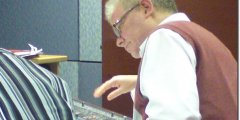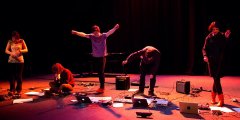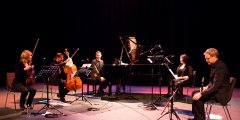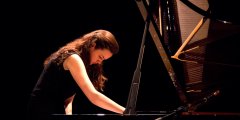
Irish composer BEN McHUGH reviews performances by David Adams, Kirkos, Con Tempo, Rhombus, and David Bremner and Elizabeth Hilliard over the first day and a half of the ICC10 Festival
David Adams (piano and harpsichord)
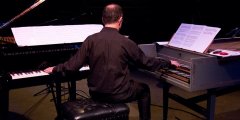
One of the founding members of the ICC, Dave Flynn, was a featured composer of the organisation's 10th Anniversary Festival. His 12-Tone B-A-C-H was a simple dodecaphonic affair using a clever 12-tone series based on Bach’s B-A-C-H motif, which is introduced on the piano before being treated fugally with a subject and counter-subject. This leads to swelling dynamics and ends with a solemn quiet ending, perhaps a lament for the form of fugue, dodecaphony as a compositional system, or for Bach himself. The piece comes across as both a critique of the twelve tone system, and as a sentiment of praise for contrapuntal writing.
The fourth piece in the programme, Toghair (an invocation) by Breffni O’Byrne, treats the piano in more of a modernist fervour with lyrical and dramatic outpouring. This piece summons a two-note figuration and gives it life through variation of tessitura and ornamentation, an approach which follows on from O’Byrne’s previous compositional research into the borrowing of techniques from traditional Irish music and transplanting them into European piano forms. The piece finishes on a tone that harks back to material from the beginning after being put through a whirlwind of sparkling piano technique, ending up as somewhat of a competition piece, never the less an exciting performance.
Luke Duffy’s piece Earthly transports us to a land of heavy chords with returning themes and phasing before almost returning to where it began. The final piece in Adams’ concert, Chris M Pearson’s Caprice, starts off with rapid toccata-like playing, reminiscent of the old honkytonk spaghetti westerns, before moving to more dissonant material and ending with a thundering seventh chord. Along with four of the ICC's newest members who only joined this year, this concert showed a sort of alpha and omega of ICC music to this point, including some of the more established Irish composers on the scene twinned with younger college-based composers. This highlighted just what the ICC is capable of — supporting composers of all styles, from humble beginnings to international recognition.
Kirkos Ensemble
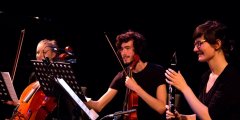
The next concert starting at 6pm was Kirkos, and after copious amounts of maté I was ready for the next instalment of ICC10. Kirkos has grown out of the need for a contemporary ensemble of student musicians playing the music of student composers in Dublin’s Royal Irish Academy of Music. Managed by Sebastian Adams and Robert Coleman, both competent performers who have studied at the academy, it’s certainly in good hands. It gives the composers stationed in the RIAM a soIid platform to get their works played and heard. I had never seen a full Kirkos line-up in concert previously, so I was eager to attend this one.
The first work for the whole group was Gemma Doherty’s A, which distributed the pitch A throughout the ensemble, using string and wind unisons and viola interjections, later evolving to polyrhythmic textures before returning to the start. Next we had Matthew Whiteside’s piano trio, entitled The World in an Oyster, An Oyster in The World, perhaps alluding to fractal or recursive structures. It begins with a returning piano ostinato in the lower left hand, which is extended by the cello. This is joined by a high piercing violin attack that stretches the timbral range of the piece enhancing the drama. The tension increases with variation and spectral additions finishing with the pulse of the piano and sustained strings.
Siobhra Quinlan’s The Shaman for full ensemble sans pianoconjured up an atmosphere of ritual, juxtaposing string harmonics and song-like woodwinds alongside recordings of drums and bells underneath a monologue of an interview explaining the nature of shamanism and describing the invisible protagonist. In addition to this, Siobhra herself was singing with the ensemble adding an extra dimension and authenticity to the pleading, longing nature of the music, before the contrapuntal and granular textures subside into more sustained textures.
Hugh Martin Boyle’s Movement for Violin, Cello and Piano introduces us to a sound world of legato strings and careful, well-placed silences opposite beating piano clusters. String resonance excites the room with a sense of sustained glacial timelessness characteristic of Boyle’s music, yet more refined than previous works.
Following Hugh’s piece there was a short interlude, which gave the ensemble time to set up for Barry O’Halpin’s Catarrh. Kirkos are joined onstage by their conductor who helps the ensemble navigate the tricky score that’s put before them; the beating of tones, the rustle of the cello, the clicking slide of a pen on the piano keys. Energy is gathered and the music finishes with playful stops-and- starts from the piano. Catarrh is probably the most experimental piece thus far in terms of timbral exploration.
Raeghnya Zutshi’s Blossoms in Ryoan-ji creates a deeper atmosphere. A rising cello is answered by the clarinet, which supports the piano as it outlines the harmony with short phrases á la John Williams' Memoirs of Geisha.In dragonflies draw flame by Finola Merivale, an overall quiet texture with dispersed swells underscored by the lack of stage lighting gives way to a sombre, almost hopeful finale.
Jenn Kirby's OneToN starts with a bluegrass-like intro for the whole ensemble, with dense microtonal glissandi and playful interaction. Pizzicato chords lead to still livelier material with the piano signalling the rhythmic changes. The winds play more of a percussive role, supporting the hits form the piano’s left hand. The third movement starts off with a diabolical totentanz akin to the music of Gerald Barry, with the cello characterised by an unpredictable furious dance, periodically returning heavier than before. This leads to a final subdued section, with the cello murmuring alongside the sustained wind unison. Brian Ingoldsby’s Seisear opens with flute and repeated chords in the piano leading to heavier material and lush sighs from the clarinet.
Con Tempo Quartet

With the order of the program being decided by the audience fishing out kinder pieces from kinder eggs in a bag and beginning with a Romanian folk tune arranged by the quartet, this was set up to become a concert of surprises right from the start. Patrick Connolly’s Extracts of music from the room next-door depicts an image of heard fragments from a traditional fiddle player practising in the next room. The piece featured sustained gestures, repetition, knocks on the body of the instruments, and harmonic glissandi.
Elis Czerniak’s piece for amplified quartet, Stirrings begins with resonant plucks contrasted by the murmur of bowed tailpieces, which are sampled and manipulated, leading to unpredictable shifts in the action and changes of mood. The piece’s main focus is an exploration of timbre and technical clarity, whilst also maintaining a shifting and undulating texture. Sebastian Adams’ String Quartet No. 1, is a work of pulsating steadfast construction in three movements; fast – slow – fast. With its ethereal inner movement of thematic swells sitting between two frenetic outer movements, this piece was certainly a crowd pleaser.
Anna Clifford’s A Healthy Sadness took on a softer tone; a plaintive piece of placelessness, which confronts the question of home. This was played by the quartet with incredible sensitivity and attention to detail. Clara Taylor’s A Contemporary Raindrop brought on a livelier mood through the use of short pizzicato material to build pulsating modal grooves between the instruments, with the ensemble interaction and sense of space apparent. Eoghan Desmond’s flights of fancie was a collection of playful and obtuse mini-movements, some containing various in-jokes (in this case a dig at the historical role of the viola in ensemble contexts), and references to kitsch parlour music of the nineteenth century.
Stephen O’Brien's Bouts felt like a radio jumping between stations; various styles were perceived to be present including aspects of traditional Irish music, sonorous pressure, romantic music and folk. These were presented in a sophisticated polystylistic, well-balanced exploration, and kept the room, and the quartet, guessing. Anna Murray’s Aside felt like a game of chess, with slight moves changing the overall feel and direction of the music, minute changes signalling large results.
Rhombus
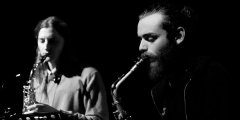
Due to the ConTempo concert running on later than expected the final group of the night, Rhombus, had less time to wow the audience. However, dropping two pieces didn’t take away from this quartet’s fantastic energy and message of group music-making. This was an effortless performance that handled the challenges of reading from audience-held scores well, and included a collaborative piece from the four composers involved called Synergy – Colour-Sound-Space, with music by Aran O’Grady, Richard Gill, Anna Clifford, Robert Coleman and the quartet.
Next up was The way things look smaller the further you walk — quite a long piece in the context of the festival so far, but nevertheless one which was expertly navigated by the group. Effortless returns to the head indicated a tight and controlled plan, which worked alongside the improvisatory structures of solos and fills that made up the bulk of this piece. Each return was more thrilling than the last. Bearing in mind the time constraints, as a member of the audience, I would have loved to see the whole set. Perhaps the ICC can organise a return or indeed repeat performance soon. Either way I’ll be sure to remember this gig for quite a while. All in all, a great finish to the first day.
David Bremner (piano) and Elizabeth Hilliard (soprano)
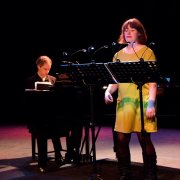
Richard Gill’s The Bridge opens the first concert of the second day by musically treating the subject of Franz Kafka’s short story of the same name. A dark opening is followed by dance-like chords in the piano, and atonal lines which rise and fall, leading to delicate occasional harmonic support by the piano, are played with great sensitivity by Bremner. Following this, we hear high, fugue-like textures, and sprechstimme from Hilliard, ending with a mechanical stop and start pulse, well-timed, and overall, a well-crafted piece, playing to both performers' strengths.
Sherry Hazlett’s A Prayer was next, and it dealt with a prayer from the composer’s own prayer book, musically shaping it for the voice and piano. The evocative, cloudy chord clusters, and the spoken text, were inflected with a post-minimalist flavour. This was followed by increasing drama and rhythmic variation through pulse-like phrases, and a softer, more powerful texture. Epic, modal, light piano arpeggios embellished the soprano’s pleading line, before finishing with a sombre heavy climax, featuring block versions of the opening chords in the final cadence. Overall, thoughtfully performed by the duo.
Massimo Davi’s Non vera historia, sed ficta fabula (not a true account, but a tale of fiction) is based on thefantastic story of a winter fairy who wakes up in summer. It is reminiscent of Moominland Winter where Moomintroll wakes up in winter after cutting his hibernation short. In Davi's version, the animated description deals with a sense of one's unease at an unfamiliar environment. Bremner and Hilliard both act the parts well, not just with each other but with audience interaction as well, breaking the fourth wall. In terms of musical material, Davi experiments with the sympathetic resonance of half-pedalled piano attacks, which contribute to a great sense of tension by subverting the audience expectation. Personally, this was my favourite piece so far in the festival, and one that was performed and acted with incredible sensitivity.
Kim V Porcelli’s To the rain in the mountain featured a song-like melodic line which Hilliard recorded into a loop pedal, accompanied by Bremner playing material from the melodic line with omitted notes. This tripartite texture gave a sense of controlled randomness, which contributed to a clear and glass-like texture of the shifting plates of process music. This was a work dealing with purity of sound, and concentrating on sounds which unfold over time, with due attention paid to acoustic detail and the act of listening.
Johanne Heraty’s The Testament of Mary was anatmospheric reflection of the poem of the same name by Aoife Nolan, featuring menacing and clever piano writing with a careful intertwining of the voice and piano. This contributed to a dark, yet thoughtful work. David Bremner’s own composition, Coming,featured the piano in a prominent place. This was a piece of contrapuntal energy and heightened contrasts between the instruments.
Ryan Molloy's Clearances was a setting of the poem of the same name by Seamus Heaney, a text that deals with the poet’s relationship with his mother, their time together and her eventual death, with personal reflections of the important moments shared. Ryan’s was a work ofsoft, yet clear textures with excellent treatment of the text. The slow, monotone vocal arcs and dramatic peaks were followed by the rumble of bass chords in the left hand of the piano. The contrasts between the text’s images and the musical material worked well, and lent themselves to an extra layer of drama. With increasing stillness and heightened emotional tension, the piece finished with high head notes from the soprano, hauntingly elongated by the piano.
Robert Coleman’s It is architecture, the final piece on this program, is a work of opposites. Through the setting of a text by Le Corbusier, the composer paints a picture of construction’s relation to art, and the concept of form. A clear monotone, rhythmic, spoken description of the nature of construction melts back to reveal a fluid, jubilant song describing the merits of form and design. The construction sections, carrying a darker side than the emotional outbursts and soaring lines of the sections on form, reinforced the dichotomy which led to quite an interesting piece overall, including another excellent setting of text.
Ben McHugh is an Irish composer currently based in Stockholm, Sweden and a member in the Association of Irish Composers.
David Adams is one of Ireland's leading exponents of contemporary music for piano, harpsichord and organ. His CD Irish Contemporary Organ Music is available from the Contemporary Music Centre in Dublin.
The Kirkos Ensemble was founded in 2012 by a group of composition and performance students from RIAM to create greater opportunities for young composers to hear their music performed and for young performers to play contemporary music. http://ensemble.ie/kirkosensemble/
The Con Tempo Quartet are Ensemble in Residence with Ireland's national broadcaster RTÉ. http://www.contempoquartet.com/
Rhombus is an ensemble of jazz soloists who explore a range of different approaches to music-making, from meditation to collaboration. http://www.denniswyers.ie/rhombus.php
David Bremner in an organist, pianist and composer. Elizabeth Hilliard is a soprano and a member of the National Chamber Choir of Ireland. They are co-founders of the Béal Music Company, which seeks to promote new music and words. https://bealfestival.wordpress.com/
Photos:
David Adams performing at ICC10, Project Arts Centre, Dublin, November 2014. Photo by Daryl Feehely
Kirkos Ensemble performing at ICC10, Project Arts Centre, Dublin, November 2014. Photo by Daryl Feehely
Con Tempo Quartet performing at ICC10, Project Arts Centre, Dublin, November 2014. Photo by Daryl Feehely
Rhombus performing at ICC10, Project Arts Centre, Dublin, November 2014. Photo by Daryl Feehely
David Bremner and Elizabeth Hilliard performing at ICC10, Project Arts Centre, Dublin, November 2014. Photo by Daryl Feehely

